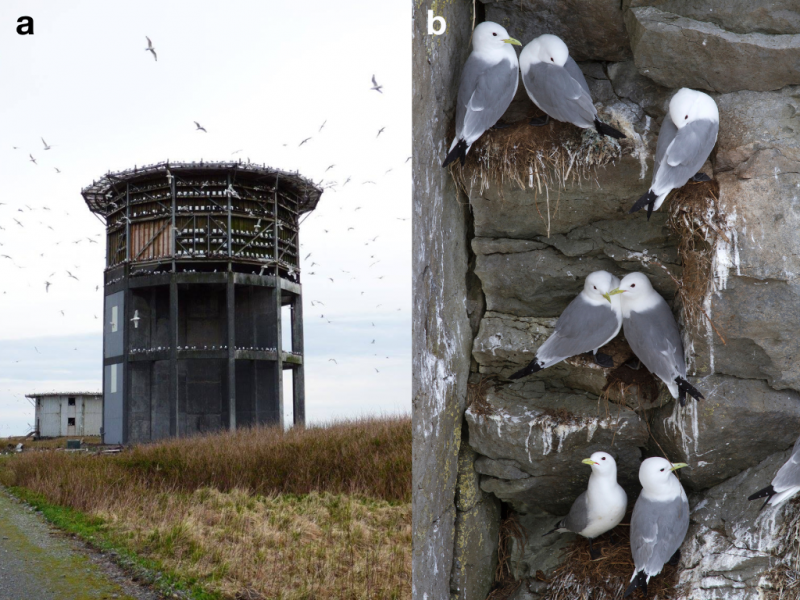Spying on Seabirds: Combining Old and New Tools to Understand How Kittiwakes Expend Energy
By Eleonore Lebeuf-Taylor
19 September 2022

(a) Cylindrical radar tower that houses research activities (photo credit: Angelika Aleksandrova Aleksieva); (b) Black-legged kittiwakes (photo credit: Dmytro Pylypenko in Colourbox).
On a small, remote island off the coast of Alaska stands a lone radar tower. Dark and empty in the winter, it turns into a flurry of activity every summer as the home of a black-legged kittiwake colony, and the scientists who visit the island to research these seagull-like birds.
Middleton Island is a long, narrow island in the Pacific Ocean about 100 kilometres south of Alaska. The radar tower, which was part of a US military base decommissioned in 1963, now houses the research activities of the Institute for Seabird Research and Conservation as well as scientists from the University of Guelph and McGill University.
It’s a place Dr. Shirel Kahane-Rapport called home while conducting her Honours’ thesis under the supervision of Dr. Shoshanah Jacobs from the Department of Integrative Biology. Her work, which explored how kittiwakes balance their energy budgets, was recently published in the journal Oecologia.
“Energy trade-offs are very important for kittiwakes because they need to put energy into reproduction during the breeding season, but they also need enough energy resources to spend the rest of the year at sea,” says Kahane-Rapport.
The kittiwake colony on Middleton Island nests on platforms installed around the outside of the cylindrical radar tower. Each nest is accessible from the inside via a small window and a tube, which enables researchers to capture the birds and provide them with extra food by funnelling fish through the tube.
“The radar tower is a unique environment in which to study the birds because we have one-way access to the birds’ nests,” explains Kahane-Rapport. “It’s a controlled environment where we know exactly who is nesting where, when their eggs hatch, how many chicks fledge, and when they leave the colony.”
Kahane-Rapport’s work involved identifying high- and low-quality kittiwakes—that is, individuals who were in good enough condition to breed early and those who were not—and providing them with extra fish at their nests. An unfed control group was also included. All the birds were fitted with GPS trackers and accelerometers, allowing the researchers to determine when, and for how long, individual kittiwakes were flying out to sea, sitting on the water—presumably after feasting on freshly caught fish—or at home with their chicks.
By combining their ability to observe kittiwakes in their nests with technological tracking tools, Kahane-Rapport and her colleagues discovered that the birds supplemented with food left their nests less often. However, when they did leave, they travelled as far as the non-fed birds.
“Both fed and unfed birds leave the colony to forage at sea and they fly to similar places, which tells us that the food is found in a specific, and limited, area,” explains Kahane-Rapport.
This, combined with the fact that kittiwakes generally return to the same nesting area year after year, may spell trouble for the birds in a rapidly changing Arctic environment.
“Kittiwakes are sensitive to environmental change because they will return to the same nest only to discover that the ocean around them is empty,” says Kahane-Rapport. “They then have to fly further and expend more energy to obtain food, which becomes a problem for their chick-rearing.”
Although more food was clearly better for kittiwakes—those that were fed also had offspring with higher survival rates—there were some unexpected results.
“Higher-quality individuals actually spent more energy to gain more resources. And they still only had two chicks. We concluded that the rest of the energy went into self-maintenance and reserves for future survival.”
Knowing how kittiwakes balance the energetic demands of breeding and survival is crucial to understanding how they may respond to a changing environment. The global population of black-legged kittiwakes has declined by 40% globally since the 1970s and anthropogenic pressures continue to mount, from heat waves and dwindling fish stocks to changes in prey communities with warmer oceans.
“The effects of environmental change, like those seen during a heat wave, linger year after year,” Kahane-Rapport notes. “In future years, is there going to be enough food for them?”
Whatever challenges the kittiwake colony faces in coming years, there will be scientists working to document them. Ongoing research at the decommissioned radar tower on Middleton Island means that the windows into the lives of black-legged kittiwakes remain open for more important Arctic research.
This study was funded by the Natural Science Engineering Research Council (NSERC) and Northern Scientific Training Program (NSTP).
Read the full study in the journal Oecologia.
Read about other CBS Research Highlights.